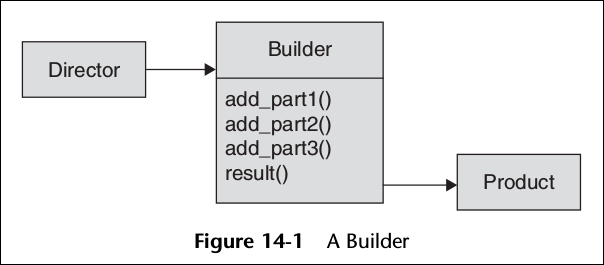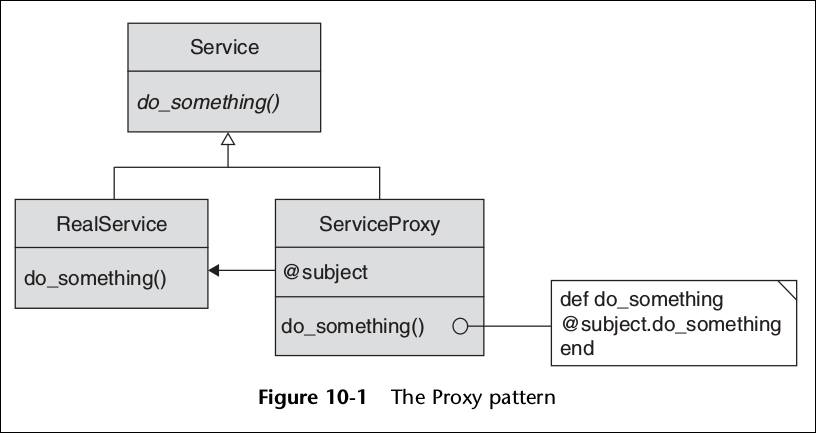Thiết kế hướng đối tượng trong Ruby on Rails
Bài đăng này đã không được cập nhật trong 4 năm
Nếu hình dung phần mềm của bạn là một căn nhà thì Design patterns chính là bản thiết kế của căn nhà đó. Hay có thể nói Design patterns là một giải pháp tối ưu trong thiết kế cấu trúc phần mềm có nguồn gốc từ lập trình hướng đối tượng (OPP). Design patterns không phụ thuộc vào bất kỳ ngôn ngữ lập trình hay công nghệ mà bạn sử dụng. Trong các dự án về Web thì design patterns đơn giản nhất mà các bạn nhìn thấy là mô hình MVC. Có 3 nhóm Design patterns chính là: Creational
- Abstract Factory
- Builder
- Factory Method
- Prototype
- Singleton
Structural
- Adapter
- Bridge
- Composite
- Decorator
- Facade
- Flyweight
- Proxy
Behavioral
- Chain of responsibility
- Command
- Interpreter
- Iterator
- Mediator
- Memento
- Observer
- State
- Strategy
- Template Method
- Visitor
Sau đây mình xin giới thiệu về một số design patterns tiêu biểu nhất. Bài viết mình có tham khảo từ các nguồn https://bogdanvlviv.github.io/posts/ruby/patterns/design-patterns-in-ruby.html https://dalibornasevic.com/posts/9-ruby-singleton-pattern
Abstract Factory
Đây là kỹ thuật nhằm tạo ra một AbstractFactory(lớp trừu tượng) cho các ConcreteFactory(lớp con hay còn gọi là lớp kế thừa), mà giữa các ConcreteFactory sẽ có một điểm chung hoặc sự phụ thuộc nào đó. AbstractFactory sẽ định nghĩa ra các phương thức và các phương thức này sẽ được cài đặt tại các ConcreteFactory. Bản chất của kỹ thuật này chính là tính kế thừa trong lập trình hướng đối tượng.

Ví dụ:
class Animal
attr_accessor :name
def initialize name
@name = name
end
def eat
end
def speak
end
def sleep
end
end
class Tiger < Animal
def eat
puts "Tiger #{name} is eating anything it wants."
end
def speak
puts "Tiger #{name} Roars!"
end
def sleep
puts "Tiger #{name} sleeps anywhere it wants."
end
end
class Frog < Animal
def eat
puts "Frog #{name} is eating anything it wants."
end
def speak
puts "Frog #{name} Roars!"
end
def sleep
puts "Frog #{name} sleeps anywhere it wants."
end
end
class Plant
attr_accessor :name
def initialize name
@name = name
end
def grow
end
end
class Tree < Plant
def grow
puts "The tree #{name} grows tall."
end
end
class Algae < Plant
def grow
puts "The tree #{name} grows tall."
end
end
class Habitat
def initialize(organism_factory, number_animals: 0, number_plants: 0)
@organism_factory = organism_factory
@animals = []
number_animals.times do |i|
animal = @organism_factory.new_animal("Animal#{i}")
@animals << animal
end
@plants = []
number_plants.times do |i|
plant = @organism_factory.new_plant("Plant#{i}")
@plants << plant
end
end
def simulate_one_day
@plants.each { |plant| plant.grow }
@animals.each { |animal| animal.speak }
@animals.each { |animal| animal.eat }
@animals.each { |animal| animal.sleep }
end
end
class JungleOrganismFactory
def new_animal name
Tiger.new name
end
def new_plant name
Tree.new name
end
end
class PondOrganismFactory
def new_animal name
Frog.new name
end
def new_plant name
Algae.new name
end
end
jungle = Habitat.new JungleOrganismFactory.new, number_animals: 1, number_plants: 4
jungle.simulate_one_day
pond = Habitat.new PondOrganismFactory.new, number_animals: 2, number_plants: 4
pond.simulate_one_day
Trong ví dụ trên thì mình có 2 AbstractFactory là Animal và Plant.
- Animal định nghĩa nghĩa ra 3 phương thức: eat, speak, sleep
- Plant định nghĩa ra một phương thức là grow
Và có 2 ConcreteFactory là Tiger và Tree. Tiger sẽ cài đặt phương thức eat, speak và sleep. Tree sẽ cài đặt phương thức grow.
Factory Method
Là các phương thức được khai báo tại AbstractFactory nhưng không được cài đặt. Ở ví dụ trên chính là các phương thức eat, speak, sleep của lớp Animal và grow của lớp Plant

Builder
Đây là kỹ thuật nhằm đơn giản hóa một đối tượng phức tạp bằng cách chia ra thành các đối tượng nhỏ hơn. Và sau đấy chúng ta lại ghép các đối tượng nhỏ này thông qua Builder để tạo thành một Product mà chúng ta mong muốn ban đầu.

Giả sử chúng ta muốn lắp ghép một chiếc máy tính Computer, Computer được cấu tạo từ Motherboard, Drive và Display(màn hình). Motherboard gồm có cpu và memory_size. Cpu lại gồm 2 loại là BasicCPU và TurboCPU. Lớp ComputerBuilder chính là Builder cung cấp những hàm lắp ghép các thành phần trong một Computer để trả ra một product thông qua hàm result. Director là một class quản lý việc lắp ghép và đưa ra sản phẩm.
Ví dụ:
class CPU
end
class BasicCPU < CPU
end
class TurboCPU < CPU
end
class Motherboard
attr_accessor :cpu
attr_accessor :memory_size
def initialize(cpu=BasicCPU.new, memory_size=1024)
@cpu = cpu
@memory_size = memory_size
end
end
class Drive
attr_reader :type # either :cd, :dvd or :hard_disk
attr_reader :size # in Mb
attr_reader :writable # true if this drive is writable
def initialize(type, size, writable)
@type = type
@size = size
@writable = writable
end
end
class Computer
attr_accessor :display
attr_accessor :motherboard
attr_reader :drives
def initialize(display=:crt, motherboard=Motherboard.new, drives=[])
@motherboard = motherboard
@drives = drives
@display = display
end
end
class ComputerBuilder
attr_reader :computer
def initialize
@computer = Computer.new
end
def basic_cpu
computer.motherboard.cpu = BasicCPU.new
end
def turbo_cpu
computer.motherboard.cpu = TurboCPU.new
end
def display=(display)
computer.display = display
end
def memory_size=(size_in_mb)
computer.motherboard.memory_size = size_in_mb
end
def add_cd(writer=false)
computer.drives << Drive.new(:cd, 760, writer)
end
def add_dvd(writer=false)
computer.drives << Drive.new(:dvd, 4000, writer)
end
def add_hard_disk size_in_mb
computer.drives << Drive.new(:hard_disk, size_in_mb, true)
end
def result
@computer
end
end
class Director
def initialize builder
@builder = builder
end
def create_company
builder.turbo_cpu
builder.add_hard_disk 1_000_000
builder.memory_size = 16000
builder.add_cd true
builder.add_dvd
computer = builder.result
end
end
Singleton
Là một design pattern giới hạn sự khởi tạo một biến instance và biến instance phải là biến toàn cục. Nó rất hữu hiệu khi bạn muốn truy cập vào các phần khác nhau của ứng dụng, thường là các chức năng đăng nhập, giao tiếp với hệ thống bên ngoài hay truy cập cơ sở dữ liệu.
Có hai cách để cài đặt singleton pattern trong Ruby:
Single Instance của một class
class Logger
def initialize
@log = File.open("log.txt", "a")
end
@@instance = Logger.new
def self.instance
return @@instance
end
def log(msg)
@log.puts(msg)
end
private_class_method :new
end
Logger.instance.log "message 1"
Trong ví dụ này, bên trong lớp Logger chúng ta tạo ra một biến instance của lớp Logger và chúng ta có thể truy cập vào biến instance này với phương thức Logger.instance. Bất kỳ khi nào chúng ta cần viết một thứ gì đó vào file log sử dụng phương thức log. Trong phương thức khởi tạo initialize chúng ta chỉ cần mở file log để thêm bất kỳ thứ gì. Ở phần cuối lớp Logger, chúng ta tạo một phương thức private new để chúng ta không thể tạo các instance mới của lớp Logger. Đó là Singleton pattern: chỉ có 1 instance và là biến toàn cục.
Ruby Singleton module
Ruby Standard Library có một module singleton để cài đặt mô hình Singleton. Cũng như ví dụ trước nếu sử dụng module singleton. Ở đây chúng ta require và include module Singleton bên trong lớp Logger, định nghĩa phương thức khởi tạo initialize, mở file log để ghi vào file log. Module singleton tạo ra sự khởi tạo lười biếng (tạo ra instance từ lớp Logger vào thời điểm chúng ta gọi phương thức Logger.instance) mà không phải trong thời gian load (giống như ví dụ trước). Ngoài ra, trong module singleton cũng tạo ra phương thức private new, do đó chúng ta không phải gọi private_class_method
require "singleton"
class Logger
include Singleton
def initialize
@log = File.open("log.txt", "a")
end
def log(msg)
@log.puts(msg)
end
end
Logger.instance.log "message 2"
Proxy
Một đối tượng đại diện cho một đối tượng khác. Tạo ra một đại diện hoặc thay vào chỗ của đối tượng khác để kiếm soát việc truy cập vào đối tượng đó. Trong ruby có gem pundit hỗ trợ việc này
 Ví dụ:
Ví dụ:
class Account
attr_reader :balance
def initialize(starting_balance=0)
@balance = starting_balance
end
def deposit amount
@balance += amount
end
def withdraw(amount)
@balance -= amount
end
end
require "etc"
class AccountProtectionProxy
def initialize(real_account, owner_name)
@subject = real_account
@owner_name = owner_name
end
def deposit amount
check_access
return @subject.deposit(amount)
end
def withdraw amount
check_access
return @subject.withdraw(amount)
end
def balance
check_access
return @subject.balance
end
def check_access
if Etc.getlogin != @owner_name
raise "Illegal access: #{Etc.getlogin} cannot access account."
end
end
end
account = Account.new(100)
account.deposit(50)
account.withdraw(10)
proxy = AccountProtectionProxy.new(account, 'russolsen')
proxy.deposit(50)
proxy.withdraw(10)
Trong ví dụ trên thì đối tượng cần thay thế (đối tượng thật) là Account và đối tượng đại diện (proxy) là AccountProtectionProxy. Ở lớp AccountProtectionProxy ta thấy có 2 phương thức withdraw và deposit tương tự như lớp Account. Nhưng với mỗi phương thức của lớp AccountProtectionProxy có thêm việc kiểm tra quyền truy cập thông qua phương thức check_access
All rights reserved